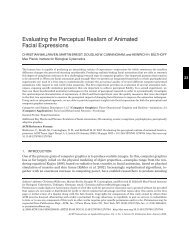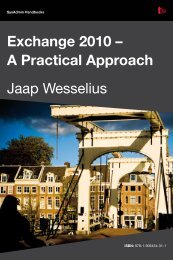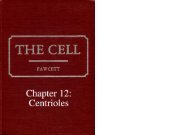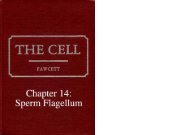An astrocyte bridge from synapse to blood flow
An astrocyte bridge from synapse to blood flow
An astrocyte bridge from synapse to blood flow
You also want an ePaper? Increase the reach of your titles
YUMPU automatically turns print PDFs into web optimized ePapers that Google loves.
news and views<strong>An</strong> <strong>astrocyte</strong> <strong>bridge</strong> <strong>from</strong> <strong>synapse</strong> <strong>to</strong><strong>blood</strong> <strong>flow</strong>Rheinallt Parri and Vincenzo Crunelli© 2003 Nature Publishing Group http://www.nature.com/natureneuroscienceNeural activity locally increases cerebral <strong>blood</strong> <strong>flow</strong> <strong>to</strong> deliver oxygen <strong>to</strong> working neurons. <strong>An</strong>ew paper shows that <strong>astrocyte</strong>s can detect activity at glutamatergic <strong>synapse</strong>s via calciumchanges in astrocytic endfeet and directly couple it <strong>to</strong> <strong>blood</strong> <strong>flow</strong> in vitro and in vivo.When neurons are active, <strong>blood</strong> <strong>flow</strong> andglucose uptake in that local brain regionincrease, supplying oxygen and energy <strong>to</strong>meet the enhanced local metabolicdemand 1,2 . This tight physiological couplingbetween neuronal activity and <strong>blood</strong><strong>flow</strong> has fascinated neuroscientists for morethan a century 3 . Its understanding has takenon greater importance in recent years, aschanges in <strong>blood</strong> oxygenation (resulting<strong>from</strong> local vasodilation and increased <strong>blood</strong><strong>flow</strong>) form the basis for techniques such asfunctional magnetic resonance imaging(f MRI) that are widely used <strong>to</strong> map bothnormal and pathological brain function 1 .There are currently three hypotheses, notmutually exclusive, of how this increased<strong>blood</strong> <strong>flow</strong> might occur. First, locally secretedsubstances such as adenosine or K + ,which are formed by the enhanced neuronalactivity, act on neighboring <strong>blood</strong> vessels<strong>to</strong> cause vasodilation 4 . Second,neuronal afferents (containing, for example,acetylcholine, monoamines or peptides)innervate the brain vasculature <strong>to</strong>control vasodilation 5–7 . Third, NMDArecep<strong>to</strong>r activation on postsynaptic neuronsleads <strong>to</strong> the stimulation of nitric oxide synthase(NOS) <strong>to</strong> produce nitric oxide (NO),which diffuses <strong>to</strong> elicit vascular smoothmuscle relaxation 8 .In this issue, Zonta et al. 9 proposean elegant new mechanism for cerebralvasodilation in which <strong>astrocyte</strong>s are pivotalintermediaries between neurons and brainmicrocirculation. The authors report thatsome <strong>astrocyte</strong>s detect the level ofglutamate-dependent synaptic activity andthen signal <strong>to</strong> adjacent cerebral vessels <strong>to</strong>cause vasodilation. This mechanism isattractive because it relies on glutamate, themost abundant CNS excita<strong>to</strong>ry transmitter,and it provides a very specific vasodilationthat is tightly linked <strong>to</strong> local synapticThe authors are at the School of Biosciences,Cardiff University, Museum Avenue, Box 911,Cardiff, CF10 3US, Wales, UK.e-mail: parri@cardiff.ac.uk;crunelli@cardiff.ac.ukactivity. Indeed, this process is consistentwith the finding that fMRI signals dependmore strongly on synaptic input <strong>to</strong> a specificbrain area than on output (actionpotentials) of neurons in that area 10 .One of the proposed functions of <strong>astrocyte</strong>sis coupling of neuronal activity <strong>to</strong>increased energy demand 11 . Glutamatetransporters on the astrocytic processes thatensheath synaptic contacts take up synapticallyreleased glutamate, which is thenmetabolized <strong>to</strong> glutamine before beingrecycled back <strong>to</strong> the neurons. Removingglutamate <strong>from</strong> the synaptic cleft helps <strong>to</strong>terminate its postsynaptic action, and itsconversion <strong>to</strong> glutamine drives glucoseuptake <strong>from</strong> local <strong>blood</strong> vessels as a sourceof energy. This is achieved through glucosetransporters that are present on other astrocyticprocesses called ‘endfeet,’ which are incontact with <strong>blood</strong> vessels.PostsynapticterminalGluRGlutamateAstrocytemGluREndfootPresynapticterminalThe results <strong>from</strong> Zonta et al. 9 now suggestthat <strong>astrocyte</strong>s also provide the linkbetween neuronal activation and vasodilation.Together with transporters, the astrocyticprocesses that ensheath synapticcontacts possess a variety of neurotransmitterrecep<strong>to</strong>rs, including both ionotropicand metabotropic glutamate recep<strong>to</strong>rs(mGluRs; Fig. 1). Activation of these recep<strong>to</strong>rsby synaptically released transmitters isknown <strong>to</strong> lead <strong>to</strong> transient and gradedincreases in intracellular Ca 2+ concentration;the <strong>astrocyte</strong> is thus able <strong>to</strong> ‘sense’ thelevel of synaptic activity 12 . Now, by showingthe coupling of synaptically releasedglutamate <strong>to</strong> Ca 2+ changes in the endfeetand <strong>to</strong> local vasodilation (Fig. 1), the Zontaet al. 9 data indicate a clear physiologicalfunction for the <strong>astrocyte</strong>’s ability <strong>to</strong> sensesynaptic activity and suggest how these cellsmay act as a unit <strong>to</strong> couple brain activityBlood vesselProstanoidreleasemGluRFig. 1. Proposed mechanism for <strong>astrocyte</strong>-mediated coupling of synaptic activity <strong>to</strong> local vasodilation.Synaptic glutamate release activates postsynaptic neuronal ionotropic glutamate recep<strong>to</strong>rs(GluRs) and astrocytic metabotropic recep<strong>to</strong>rs (mGluRs). Activation of mGluRs induces a transientincrease in intracellular Ca 2+ , which propagates throughout the <strong>astrocyte</strong> and <strong>to</strong> its endfoot.The Ca 2+ increase elicits production of arachidonic acid (AA) <strong>from</strong> phosphatidylinosi<strong>to</strong>l (PI), mostlikely by activation of phospholipase A 2 (PLA 2 ). The action of cyclooxygenase (COX) producesprostanoid products that cause vasodilation, and agents such as aspirin or indomethacin can blockthis COX action.PICa 2+PLA 2 ?AAAspirinCOXIndomethacinProstanoidIvelisse Roblesnature neuroscience • volume 6 no 1 • january 2003 5
news and views© 2003 Nature Publishing Group http://www.nature.com/natureneurosciencenot only <strong>to</strong> energy demands but also <strong>to</strong><strong>blood</strong> <strong>flow</strong> requirements.To investigate the mechanisms underlyingcerebral vasodilation, Zonta et al. 9 usedacutely isolated slices of cerebral cortex inwhich the structural and functional integrityof neurons, <strong>astrocyte</strong>s and <strong>blood</strong> vesselswas maintained. Electrical stimulation ofglutamatergic afferents in the slices causedneuronal excitation and dilation of <strong>blood</strong>vessels, as expected. Calcium imaging experimentsshowed that during synaptic stimulation,calcium concentration increased inthe <strong>astrocyte</strong> processes that ensheath synapticcontacts, and these calcium increasespropagated <strong>to</strong> the <strong>astrocyte</strong> soma and onin<strong>to</strong> the <strong>astrocyte</strong> endfeet (Fig. 1). Vasodilationwas only observed when this propagationoccurred, and the calcium increasesin the <strong>astrocyte</strong> endfeet were also correlatedwith the time course of the vasodilation.Perhaps surprisingly, the authors showlittle involvement of NO in this sequence ofevents. Incubation with the NOS inhibi<strong>to</strong>rL-NAME caused constriction over time,indicating a role for constitutive NOSexpression in setting the vascular <strong>to</strong>ne.However, neither L-NAME nor NMDArecep<strong>to</strong>r antagonists reduced the vasodilationelicited by afferent stimulation, excludingan effect of neuronal NO production inthis mechanism.On the other hand, Zonta et al. 9 foundthat antagonists of metabotropic glutamaterecep<strong>to</strong>rs (mGluRs) inhibited astrocytic calciumincreases and vasodilation, indicatinga role for these astrocytic recep<strong>to</strong>rs inmatching synaptic activation <strong>to</strong> thevasodila<strong>to</strong>ry response. Eliciting astrocyticcalcium increases with the mGluR agonisttrans-ACPD also resulted in vasodilation,indicating that mGluR activation and astrocyticcalcium increases are involved inmediating vasodilation. Direct confirmationthat the astrocytic activation was ultimatelyresponsible for the vasodilation wasachieved using patch electrodes <strong>to</strong> stimulateindividual <strong>astrocyte</strong>s. Mechanical stimulationduring seal formation, ordepolarization of the patched <strong>astrocyte</strong>s, led<strong>to</strong> the dilation of the adjacent vessel.Remarkably, and crucially, the authorswere also able <strong>to</strong> confirm their resultsin vivo using a standard soma<strong>to</strong>sensorystimulation pro<strong>to</strong>col. Using laser Doppler<strong>flow</strong>metry <strong>to</strong> directly measure <strong>blood</strong> <strong>flow</strong>,they showed that the cerebral <strong>blood</strong> <strong>flow</strong>increase observed in the contralateralsoma<strong>to</strong>sensory cortex after forepaw stimulationwas markedly inhibited (66%) byintravenously injected mGluR antagonists,whereas the evoked neuronal activityrecorded in the same cortical region wasunaffected. This finding, <strong>to</strong>gether with thein-vitro data, suggested that <strong>astrocyte</strong>-mediatedvasodilation is the major mechanismof coupling neuronal activity <strong>to</strong> <strong>blood</strong> <strong>flow</strong>in the brain, and a major component of thesignals that are recorded in fMRI studies.What is the nature of the astrocyticsignal that mediates vasodilation? Astrocytesare known <strong>to</strong> release, in a calciumdependentmanner, a number ofcompounds that have neuroactive or neuromodula<strong>to</strong>ryactions, including ATP andglutamate 12 . Zonta et al. 9 , however, foundthat vasodilation was blocked byindomethacin and aspirin, both inhibi<strong>to</strong>rsof cyclooxygenase (COX), indicating thatthe compound(s) released <strong>from</strong> the <strong>astrocyte</strong><strong>to</strong> cause <strong>blood</strong> vessel dilation is a COXproduct. The pathway elucidated by Zontaet al. 9 , therefore, seems <strong>to</strong> be that a rise incalcium in the <strong>astrocyte</strong> activates phospholipaseA 2 <strong>to</strong> produce arachidonic acid, <strong>from</strong>which COX catalyzes the production of arange of products (and their metabolites)that have vasoactive actions, includingprostaglandins and prostacyclin (Fig. 1).This study raises a number of questions.What is the identity of the releasedfac<strong>to</strong>r? The prime candidate seems <strong>to</strong> bePGE 2 , as it can be released <strong>from</strong> <strong>astrocyte</strong>sin a calcium-dependent manner 13 . Indeed,application of PGE 2 caused vasodilation inthe same vessels dilated by synaptic stimulation,presumably indicating the presenceof functional prostaglandinrecep<strong>to</strong>rs 9 . The possibility remains, however,that other fac<strong>to</strong>rs may mediate orcontribute <strong>to</strong> the vasodilation.The site and mechanism of action of thevasodilation also remain unknown.Notably, is it a direct action on smoothmuscle cells, or are the endothelial cellsinvolved? The vasodilation could be due <strong>to</strong>activation of second messenger pathwayssuch as soluble guanylyl cyclase, as occurswith NO, or direct activation of K + channels<strong>to</strong> cause membrane hyperpolarization,as proposed for endothelial- derived hyperpolarizingfac<strong>to</strong>r (EDHF) 14 .There are great technical difficulties inaddressing such issues, but the preparationused by Zonta et al. 9 provides promisingpossibilities. One of the hurdles in thisstudy was <strong>to</strong> simultaneously measure astrocyticcalcium and vasodilation, as well assmooth muscle or endothelial calciumchanges. The use of transgenic techniques,such as the expression of fluorescent proteinsin smooth muscle cells, would allowthe concomitant moni<strong>to</strong>ring of astrocyticcalcium changes and vasodilation and amore rigorous analysis of the temporalaspects of the mechanism. In addition,measuring calcium in endothelial andmuscle cells would greatly help in determiningthe vasodila<strong>to</strong>ry mechanism, especiallywith respect <strong>to</strong> EDHF, which involvescharacteristic calcium changes in endothelialand smooth muscle cells 14 .As mentioned earlier, activation ofneurotransmitter recep<strong>to</strong>rs on the <strong>astrocyte</strong>sleads <strong>to</strong> a transient increase in intracellularcalcium. As <strong>astrocyte</strong>s in differentbrain areas express different neurotransmitterrecep<strong>to</strong>rs 12,15 , could the processdescribed by Zonta et al. 9 be a generalmechanism for vasodilation in regionswhere glutamate is not the main transmitter?Might <strong>astrocyte</strong>s also serve an integrativefunction that could explain whythey have different transmitter recep<strong>to</strong>rs?In addition <strong>to</strong> describing a mechanismof cerebral vasodilation and extending theknown reper<strong>to</strong>ire of astrocytic functions,the findings of Zonta et al. 9 are importantfor our knowledge of astrocytic roles, asthey define a functional subtype of <strong>astrocyte</strong>sthat might represent a pivotal pointin brain physiology. Identifying the cellularmedia<strong>to</strong>r and biochemical pathways underlyingcerebral vasodilation is essential inunderstanding brain microcirculation andwill also aid in studying pathophysiologicalconditions with a new understanding ofthe central role of <strong>astrocyte</strong>s.1. Raichle, M.E. Proc. Natl. Acad. Sci. USA 95,765–772 (1998).2. Bonven<strong>to</strong>, G., Sibson, N. & Pellerin, L. TrendsNeurosci. 25, 359–364 (2002).3. Roy, C.S. & Sherring<strong>to</strong>n, C. J. Physiol. (Lond.)11, 85–108 (1890).4. Faraci, F.M. & Heistad, D.D. Physiol. Rev. 78,53–97 (1998).5. Krimer, L.S., Muly, E.C., Williams, G.V. &Goldman-Rakic, P.S. Nat. Neurosci. 1, 286–289(1998).6. Reinhard, J.F. Jr., Liebmann, J.E., Schlosberg,A.J. & Moskowitz, M.A. Science 206, 85–87(1979).7. Vaucher, E. & Hamel, E. J. Neurosci. 15,7427–7441 (1995).8. Iadecola, C. Trends Neurosci. 16, 206–214(1993).9. Zonta, M. et al. Nat. Neurosci. 6, 43–50(2003).10. Logothetis, N.K., Pauls, J., Augath, M., Trinath,T. & Oeltermann, A. Nature 412, 150–157(2001).11. Pellerin, L. & Magistretti, P.J. Proc. Natl. Acad.Sci. USA 91, 10625–10629 (1994).12. Haydon, P.G. Nat. Rev. Neurosci. 2, 185–193(2001).13. Bezzi, P. et al. Nature 391, 281–285 (1998).14. Busse, R. et al. Trends Pharmacol. Sci. 23,374–380 (2002).15. Verkhratsky, A., Orkand, R.K. & Kettenmann,H. Physiol. Rev. 78, 99–141 (1998).6 nature neuroscience • volume 6 no 1 • january 2003









